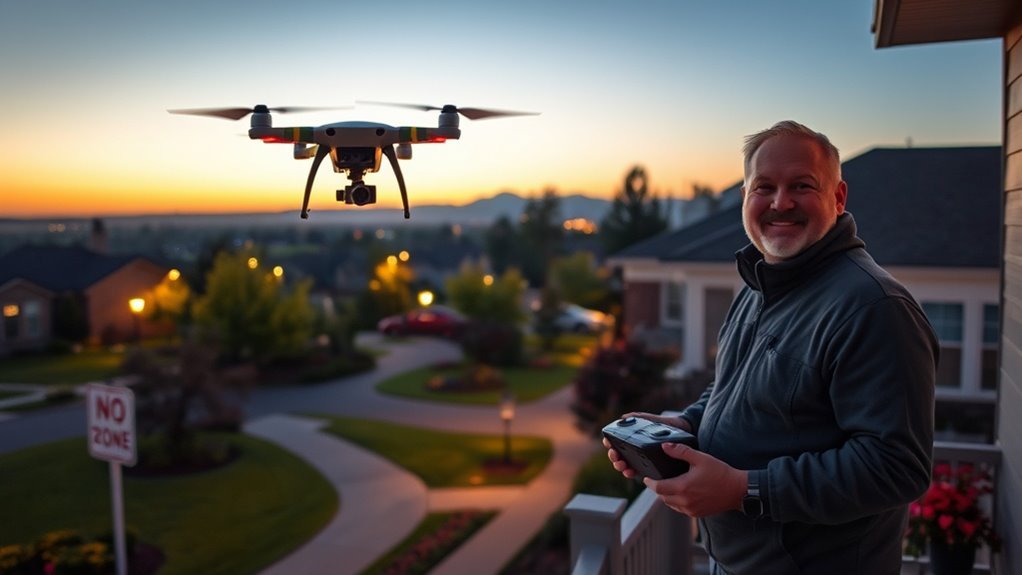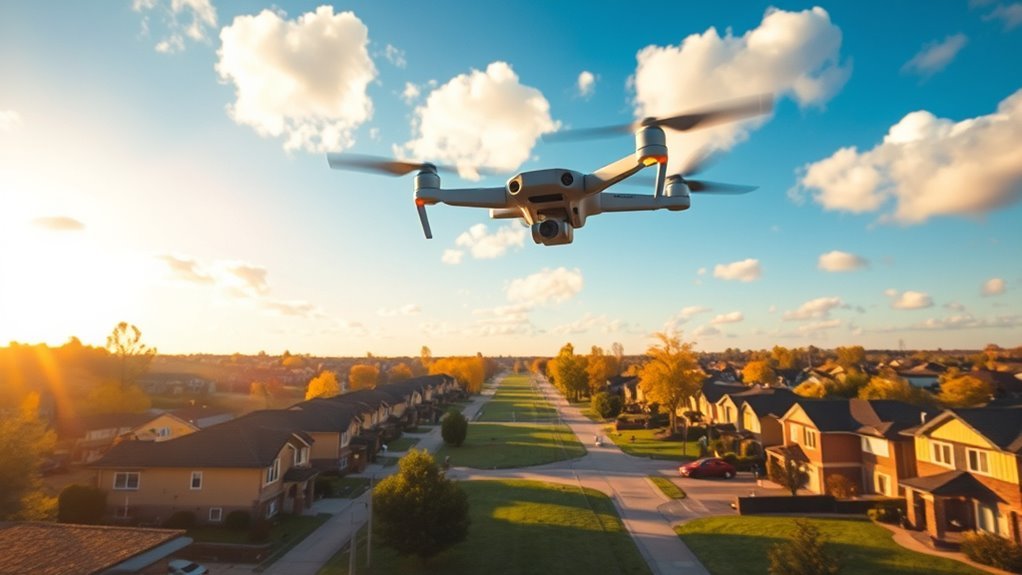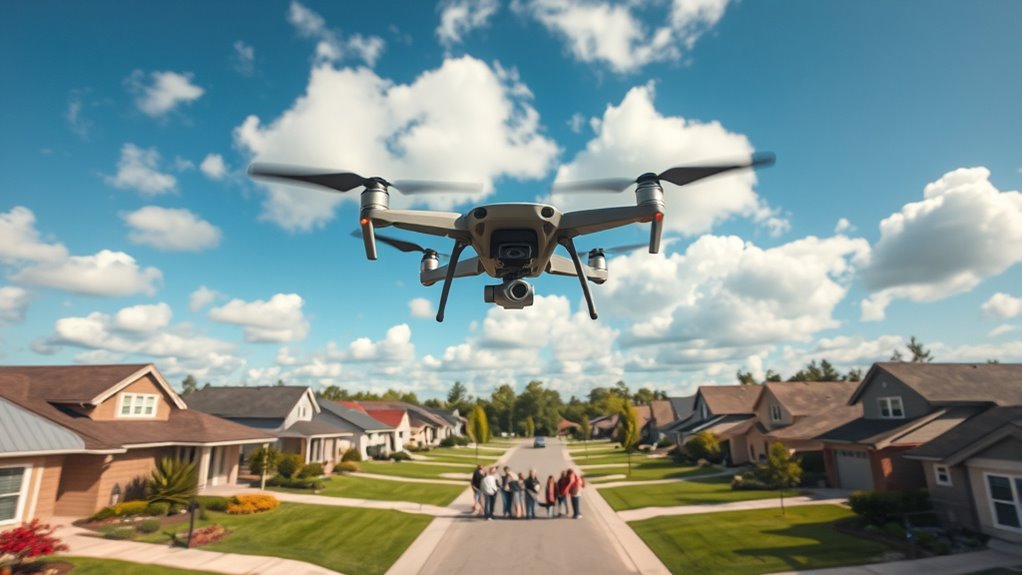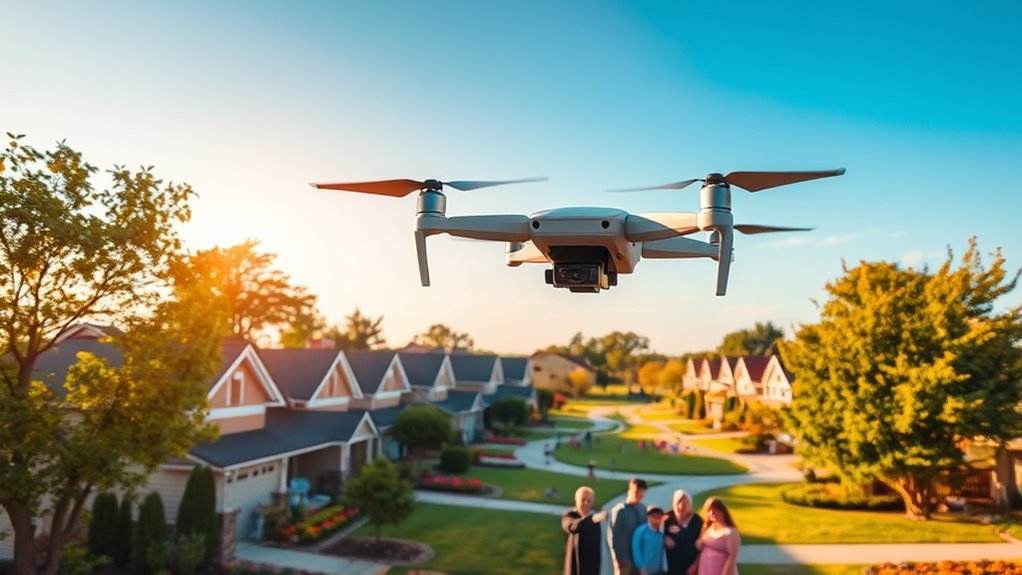To legally fly your drone in your neighborhood, you need to understand local regulations, register your drone if it weighs over 0.55 pounds, and obtain necessary permits if required. Respect privacy by avoiding hovering over private properties and limiting noise during flight. Always follow safety guidelines, keeping your drone below 400 feet and away from people and no-fly zones. By adhering to these rules, you’ll contribute to a safer flying environment and a well-informed community. Explore further for more insights.
Understand Local Drone Regulations

Before you take to the skies with your drone, it’s essential to understand local drone regulations, as these rules can vary greatly from one area to another. Familiarize yourself with your community’s specific guidelines to guarantee you’re not only flying responsibly but also legally. Local enforcement agencies often monitor drone activity, so being aware of any restrictions, such as no-fly zones or altitude limits, is vital. Engaging with community awareness initiatives can help you stay informed about any changes in regulations. Additionally, consider informing neighbors about your drone usage to foster a positive relationship and avoid misunderstandings. By respecting these regulations, you can enjoy the freedom of flying while contributing to a harmonious community atmosphere. Moreover, knowledge of state and local laws is crucial to ensure you comply with all relevant guidelines when operating your drone.
Register Your Drone

Before you take to the skies, you need to understand the registration requirements for your drone. Completing the online registration process is vital to guarantee you’re flying legally and avoid potential penalties. Make sure to check the specific guidelines based on your drone’s weight and intended use.
Understand Registration Requirements
Understanding the registration requirements for flying drones is crucial for any operator looking to comply with federal regulations. To legally operate your drone, you must guarantee it meets the drone registration criteria set by the FAA. If your drone weighs more than 0.55 pounds (250 grams), you’re required to register it. This process is straightforward but imperative; failure to comply with these legal requirements can result in penalties. You’ll need to provide your name, address, and email to complete the registration. Additionally, you’ll receive a registration number that must be displayed on your drone. By adhering to these regulations, you not only protect your freedom to fly but also contribute to safer skies for everyone.
Complete Online Registration Process
Completing the online registration process for your drone is a straightforward yet essential step in ensuring compliance with FAA regulations. This process not only promotes drone safety but also empowers you to enjoy the freedom of flying responsibly.
Here’s how to complete your online registration:
- Visit the FAA’s registration website: Locate the official portal dedicated to drone registration.
- Provide necessary information: Enter your details, including name, address, and email, along with your drone’s make and model.
- Pay the registration fee: A small fee is required, which supports safety initiatives.
Once you’ve completed these steps, you’ll receive your unique registration number, allowing you to fly with confidence in your neighborhood!
Obtain Necessary Permits

As you commence on your journey to fly drones legally, obtaining the necessary permits is essential to guarantee compliance with local and federal regulations. First, identify the permit types required for your specific drone activities, whether recreational or commercial. The Federal Aviation Administration (FAA) often mandates a Part 107 certification for commercial use, while some local jurisdictions may require additional permits for flying in certain areas. Next, familiarize yourself with the application process; this typically involves submitting forms online and may require proof of insurance or safety training. Make sure to stay informed about any evolving regulations in your area to maintain your flying freedom while ensuring safety and compliance.
Respect Privacy Concerns
How can you guarantee that your drone flying respects the privacy of others? It’s vital to understand and acknowledge privacy boundaries in your neighborhood. Practicing ethical flying not only fosters good relations but also keeps you compliant with local regulations. Here are three essential tips:
- Stay away from private properties: Avoid hovering over homes or yards to respect personal space.
- Limit flight times: Fly during reasonable hours to minimize disturbances and respect your neighbors’ privacy.
- Communicate with your neighbors: Inform them about your flying plans, which builds trust and alleviates concerns.
Follow Safety Guidelines
To fly your drone legally, you need to know the local regulations that apply to your area. It’s essential to maintain safe distances from people, vehicles, and structures to prevent accidents and comply with safety standards. By adhering to these guidelines, you guarantee a responsible flying experience while protecting yourself and others. Additionally, understanding local regulations is crucial to avoid potential legal issues during your drone flights. Always remember to operate your drone within line-of-sight to ensure safety and compliance with the rules.
Know Local Regulations
Before you take to the skies with your drone, understanding local regulations is essential for a safe and legal flying experience. By familiarizing yourself with the rules, you can promote community engagement and enhance neighborhood awareness. Here are three key aspects to contemplate:
- Airspace Restrictions: Know where you can and can’t fly, especially near airports or restricted areas.
- Privacy Laws: Respect the privacy of your neighbors; avoid flying over private property without permission.
- Local Ordinances: Check for specific rules your city or county may have regarding drone use, including noise and flight times.
Maintain Safe Distances
While flying your drone offers exciting possibilities, maintaining safe distances is essential for ensuring both safety and compliance with regulations. To avoid accidents, keep your drone’s altitude below 400 feet, as this is the maximum height allowed for most recreational flights. Be mindful of your flight patterns—maintain a safe distance from people, vehicles, and structures. Ideally, stay at least 25 feet away from individuals not involved in your drone operation. Additionally, avoid flying near airports, schools, or other sensitive areas, as this can lead to serious legal repercussions. By following these guidelines, you’ll enjoy the freedom of flying while prioritizing safety for yourself and your community. Stay informed, and respect the airspace, ensuring a harmonious experience for everyone involved.
Know the No-Fly Zones
Understanding no-fly zones is vital for anyone operating a drone. Ignoring these regulations can lead to hefty fines or legal trouble, so it’s important to familiarize yourself with no fly maps and airspace classes. Here are three key areas to check:
Familiarizing yourself with no-fly zones is crucial for safe and responsible drone operation.
- Airports: Stay clear of the airspace around airports where manned aircraft operate frequently.
- Military Bases: These zones often have strict regulations due to national security concerns.
- Public Events: Large gatherings, like concerts or sports events, may have temporary no-fly restrictions.
Always consult updated no fly maps before flying to guarantee you’re compliant. Knowing these zones not only keeps you safe but also lets you enjoy the freedom of flying responsibly. Additionally, being aware of federal oversight can help you understand your responsibilities as a drone operator.
Frequently Asked Questions
Can I Fly My Drone at Night in My Neighborhood?
You can fly your drone at night, but you must adhere to drone regulations. Make certain your drone has proper lighting for visibility, and be mindful of local laws that may prohibit night flying in residential areas.
What Are the Penalties for Flying a Drone Illegally?
If you violate drone regulations, you could face legal consequences like fines or confiscation of your drone. It’s essential to understand the rules to enjoy flying freely while avoiding potential penalties that could limit your freedom.
How Do I Report a Drone Complaint in My Area?
If a drone’s buzzing disrupts your peace, gather details on its flight. Report noise complaints to local authorities, referencing drone regulations. Your voice can help restore tranquility, ensuring everyone enjoys their freedom in the skies.
Can I Fly My Drone Near Schools or Parks?
You can’t fly your drone near schools or parks without adhering to drone regulations. Make certain you’re aware of specific restrictions in school zones, as violating these rules could lead to fines or other penalties.
What Insurance Do I Need for Flying a Drone?
When flying your drone, you’ll need liability insurance to cover potential damages. This insurance coverage protects you from financial losses if accidents occur, ensuring you can enjoy your flying experience without excessive worries or risks.

